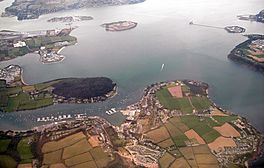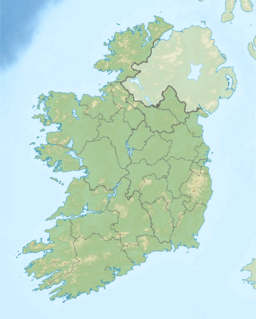Cork Harbour facts for kids
Quick facts for kids Cork Harbour |
|
|---|---|

Aerial view of lower Cork Harbour from Crosshaven (south/foreground) to Great Island
|
|
 |
|
| Location | Cork |
| Coordinates | 51°51′N 8°16′W / 51.850°N 8.267°W |
| River sources | River Lee |
| Ocean/sea sources | Celtic Sea |
| Basin countries | Ireland |
| Settlements | Cork |
| Designated: | 7 June 1996 |
| Reference #: | 837 |
Cork Harbour (called Cuan Chorcaí in Irish) is a large natural harbour and river mouth in County Cork, Ireland. It's where the River Lee meets the sea. Many people say it's the second largest natural harbour in the world by how much space ships can use. Other big harbours like Halifax Harbour in Canada and Port Jackson in Australia also claim this title.
For hundreds of years, Cork Harbour has been a busy port and an important place for defence. Since the early 1900s, it has been a major area for jobs in Ireland. While some older industries like steel-making and shipbuilding have closed, the harbour is still very important for making energy, shipping goods, and producing medicines.
Contents
Exploring Cork Harbour's Geography
The main river flowing into the harbour is the River Lee. After passing through Cork city, the river goes into the upper part of the harbour, called Lough Mahon. It then flows west of Great Island before reaching the lower harbour near Haulbowline Island.
For easier understanding and for protecting nature, the harbour is often split into two parts. "Upper Cork Harbour" follows the River Lee from Cork city to towns like Passage West and Monkstown. "Lower Cork Harbour" is separated from the upper part by Great Island. The harbour's depth ranges from about 7 metres to 26 metres.
Islands of Cork Harbour
Cork Harbour has many islands of different sizes. Some of these islands are connected to the mainland by bridges. Many islands have been, or still are, home to people.
- Great Island – This is the biggest island in Cork Harbour. The town of Cobh is located here.
- Fota Island – This island is home to Fota Wildlife Park, a golf course, and a historic house and gardens.
- Little Island – This area has both homes and businesses.
- Haulbowline Island – This island is the main base for the Irish Naval Service. It was once home to an old sailing club.
- Spike Island – This island used to be a prison.
- Harper Island, County Cork
- Hop Island, County Cork – This island has a horse riding centre.
- Weir Island, County Cork
- Brick Island, County Cork
- Corkbeg Island, County Cork – The Whitegate Oil Refinery is located here.
- Brown Island, County Cork
- Rocky Island – This island once stored gunpowder for the British Navy. It is now home to a crematorium.
Towns and Villages Around the Harbour
Cork city sits a bit upstream on the River Lee, at the northwest edge of Cork Harbour. Some parts of Cork city, like Blackrock and Mahon, are right on the upper harbour.
The lower harbour has several towns along its edges. Passage West, Monkstown, and Ringaskiddy are on the western side. Crosshaven is on the southwestern shore. Great Island, which forms the northern edge of the lower harbour, has the town of Cobh. In 2011, Cobh had about 12,500 people living there. The eastern shore is less populated, but has two villages: Whitegate and Aghada. Both have power plants.
The village of Ballinacurra is on a northeastern arm of the harbour. It is now almost a part of the town of Midleton.
Military History of Cork Harbour
Cork Harbour is the main base for the Irish Naval Service. Before 1938, it was a very important base for the British Royal Navy.

Some of the first forts in Cork Harbour were built in the 1600s. They were meant to protect Cork city. In the 1700s, more forts were built near Haulbowline Island to protect the ships anchored in Cobh. These included Cove Fort (built in 1743). Fort Camden and Fort Carlisle were built at the harbour entrance during the American Revolutionary War.

The harbour became even more important during the Napoleonic Wars. The British Navy moved its base from Kinsale to Cork Harbour. This allowed them to guard the entrance to the English Channel and block France. During this time, the naval dockyard on Haulbowline Island was built. A fort was also built on Spike Island (later called Fort Westmoreland). Many Martello Towers and other forts were also added or improved around the harbour.
The forts were improved throughout the 1800s. Another fort, Fort Templebreedy, was added south of Fort Camden in the early 1900s.
When Ireland became independent, Cork Harbour was one of three "treaty ports" that stayed under British control. The naval dockyard on Haulbowline Island was given to the Irish Free State in 1923.

The British government decided to hand over the treaty ports in March 1938. On July 11, 1938, the forts at Cork Harbour were given to the Irish military.
Since then, most of the military buildings are no longer used for military purposes. Fort Carlisle was renamed Fort Davis and is used for training. Fort Camden became Fort Meagher. It is no longer used by the military but has been restored by volunteers and can be visited. Spike Island, which was a prison, is now a tourist attraction. However, the forts on Haulbowline Island are still used and are the headquarters of the Irish Naval Service.
Industry in Cork Harbour
Cork Harbour is one of Ireland's most important industrial areas. While older industries like shipbuilding and steel-making have stopped, new industries have taken their place. Cork Harbour is now very important for making medicines. Large international companies like Pfizer and GlaxoSmithKline have factories here. These companies provide many jobs in the area.
Ireland's only oil refinery is located at Whitegate, on the southeastern side of the harbour.
Marine Activities in Cork Harbour
Commercial Shipping
The Port of Cork Company manages the harbour's shipping and port facilities. It was first set up in 1814. Very large ships, up to 90,000 tonnes, can enter the harbour. As the shipping channels get shallower further inland, only ships up to 60,000 tonnes can sail past Cobh.
The Port of Cork helps ships enter the harbour safely. All large ships must have a special pilot guide them.
The Port of Cork has places for ships to dock in Cork city, Tivoli, Cobh, and Ringaskiddy. The docks in Cork city are mainly for grain and oil. Tivoli handles containers, oil, and cars. Ringaskiddy has a deep-water port and a ferry terminal. You can take a ferry from here to Roscoff in France.
The Port of Cork is a company that runs the harbour's business. It is also in charge of navigation and docking. In 2011, the port earned €21.4 million. They had plans to build a new container facility at Ringaskiddy. This project started in 2018.
More cruise ships have been visiting Cork Harbour in recent years. In 2011, 53 cruise ships visited. Most of these ships dock at Cobh. Historically, Cobh was a main port for Irish people leaving the country during the Irish Potato Famine in the 1840s.
There are also many private docks around the harbour. These are found in places like Whitegate, Passage West, and Ringaskiddy.
Fun on the Water
The Royal Cork Yacht Club is said to be the oldest yacht club in the world. It started in the 1720s on Haulbowline Island. The club later moved to Cobh and then to Crosshaven. There are also boatyards and marinas in Crosshaven. Another marina is on Great Island.
Places like Monkstown and Blackrock are popular for boating, canoeing, windsurfing, and jet-skiing. Several rowing clubs have facilities on the River Lee between Cork city and Blackrock.





